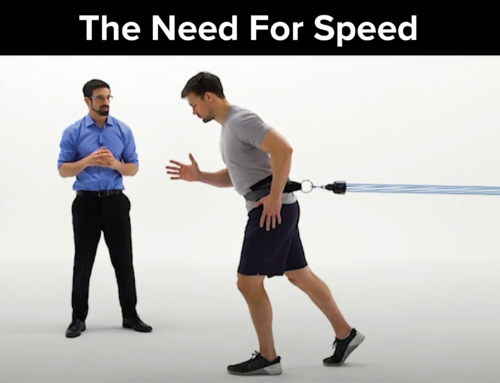We are often tasked with rehabilitating athletes who have return to sport or intense physical activity as their primary goal. Are we adequately challenging these people in the rehab setting enough to smoothly transition them back into their sport or hobby and mitigate reinjury?
Participation in athletic competition has grown over the last 30 years.1 With this increase in sport involvement, we have also seen a rise in injury rates. Interestingly, some studies have shown that athletes are three times more likely to reinjure themselves after an initial injury as opposed to suffering a new injury.2
In rehabilitative settings, we encounter a multitude of athletes playing a variety of different sports. The challenge is that each sport places its own unique physical demands on the body. When working with an athlete, even in the initial stages of rehabilitation, it is important to begin with the end goal in mind. Therefore, it is critical to understand the unique requirements of each patient’s sport. What goes into determining the physical demands of a sport through the lens of rehabilitation?
Directional Carryover
Every sport can be evaluated by its primary planes of motions: sagittal, frontal, and transverse.



Furthermore, each sport can be broken into percentages of four categories: speed, power, agility, and endurance. For instance:

Combining our knowledge related to planes of motion (sagittal, frontal, and transverse) and sport categories (speed, power, agility, and endurance) allows us to create targeted rehabilitation and return-to-sport programs for athletes.
Imagine that you are developing a plyometric program for two athletes with the same injury who are ready to return to sport. One is a 100-meter sprinter and the other is a competitive mogul skier.
How would you treat each athlete differently in the late stages of rehabilitation?
Sprinting is a unilateral task primarily performed in the sagittal plane and utilizing speed; thus, creating a single leg sagittal plane program will most closely mimic these demands. Conversely, mogul skiing is a bilateral activity that biases the frontal/transverse planes during weight shifts and requires agility; therefore, a frontal/transverse plane bilateral program will be best for this athlete.
This clip shows a six-step double limb plyometric progression that can be used for a sprinter.
[youtube v=”YFa8B_PWWoc”]
This clip shows an example of frontal and transverse plane agility hop exercises that can be used for a mogul skier.
[youtube v=”P7RkZaVu_K0″]
Body Position
Body position is another important variable to manipulate for therapeutic exercise prescription. The goal is to mimic the positions the patient will assume when they return to their sport; therefore, we must consider variables related to body position when selecting exercises.
Below are three examples from different sports—baseball, swimming, and running—showing how to vary body positions to mimic movement in each sport.
See below for an example of an abdominal isometric exercise in the cocking phase of the throwing cycle.
[youtube v=”zLoIcz7OHtA”]
See below for an example of a serratus anterior exercise for improving upward rotation during the freestyle swim stroke in the swimming position using an exercise ball and CLX band.
[youtube v=”n-HOOUf__Bk”]
See below for an example of an exercise to improve hamstring strength in half kneel to mimic the running stride.
[youtube v=”END0tGtWv-c”]
Speed of Muscle Contraction
Manipulating stress on the body can be a powerful way to prepare patients for return to their sport.
Speed of contraction takes into account the rate of force generated by the target muscle group in a given activity. Training a muscle group at a velocity specific to the goal activity will increase the likelihood that your trained skills will transfer to your performance.3 Thus, it is recommended to have patients perform therapeutic exercise at speeds that mimic their sport. This can be done with large arcs of motion or small oscillations within a given range.
The video below is an example of a throwing-specific exercise that then utilizes small oscillatory movements (perturbations) to incorporate speed of force generation and mimic the demands of throwing.
[youtube v=”PsKUTrKUftk”]
Fatiguability
Fatiguability is an important concept to consider when ensuring that a patient’s body is physically prepared for the unique challenges of their goal. Muscle fatigue has been shown to negatively impact biomechanics and performance, which can increase risk of injury.4 Therefore, it is effective to test and train movement patterns when the athlete is fatigued to reproduce conditions that are reflective of when injury is most likely to occur.
This below video describes a research article by Orishimo, et al., about the effects of fatigue on body mechanics and its potential role in increasing the likelihood of injury.5
[youtube v=”PsKUTrKUftk”]
The systematic breakdown of a sport into its planes of motion and unique physical components will help rehab professionals appropriately select and prescribe therapeutic exercises with directional carryover. By staying mindful of the concepts of body position, speed of muscle contraction, and fatigability to increase specificity of their exercises, you can effectively prepare your patients for returning to sport with a reduced risk for reinjury.
Authors
About Jared Vagy, PT, DPT, OCS, CSCS

Dr. Vagy received his Doctorate in Physical Therapy (DPT) from the University of Southern California (USC). He has completed a one-year residency in orthopedics and a one-year fellowship in movement science. Dr. Vagy is a Clinical Assistant Professor of Physical Therapy in the DPT program at USC. He has published three books and numerous articles on injury prevention. Dr. Vagy delivers lectures and seminars internationally on the topic of The Movement System. He is an orthopedic clinical specialist and a certified strength and conditioning specialist.
Dr. Vagy has served as a physical therapist in China for the Chinese National Track and Field Team, worked with USA Track and Field at the Olympic Team Trials, completed a rotation at the US Olympic Training Center working primarily with USA Men’s gymnastics, and provided medical care at international events such as the International Weightlifting Federation World Championships. He has rehabilitated several world champions, gold medalists, and Olympic athletes. His assessments and treatments are rooted deeply in an understanding of The Movement System.
About Aaron Atkins, DPT
References
- National Federation of State High School Associations. (n/d). Participation Statistics. Retrieved from https://members.nfhs.org/participation_statistics
- Rauh, M. J., Macera, C. A., Ji, M., & Wilksten, D. L. (2007). Subsequent injury patterns in girls’ high school sports. Journal of Athletic Training, 42(4), 486–494.
- Janusevicius, D., Snieckus, A., Skurvydas, A., Silinskas, V., Trinkunas, E., Cadefau, J. A., & Kamandulis, S. (2017). Effects of high velocity elastic band versus heavy resistance training on hamstring strength, activation, and sprint running performance. Journal of Sports Science and Medicine, 16(2), 239–246.
- Pinniger, G. J., Steel, J. R., & Groeller, H. (2000). Does fatigue induced by repeated dynamic efforts affect hamstring muscle function? Medicine and Science in Sports and Exercise, 32(3), 647–653.
- Orishimo, K. F. & Kremenic, I. J. (2006). Effect of fatigue on single-leg hop landing biomechanics. Journal of applied biomechanics, 22(4), 245–254.
- The original article and associated course can be found on the Medbridge blog page at this link: Click here








Leave A Comment